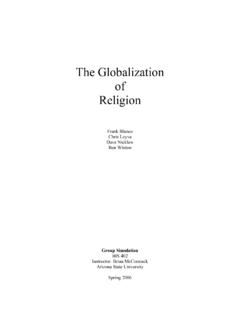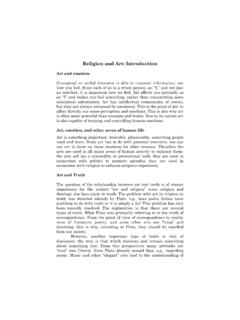Transcription of CULTURE RELIGION AND GENDER - ips.org
1 1A TRAINING MANUAL FOR THE MEDIACULTURE, RELIGION AND GENDERINTER PRESS SERINTER PRESS SERINTER PRESS SERINTER PRESS SERINTER PRESS SERVICEVICEVICEVICEVICE2 Inter Press ServiceFirst Published 2002 Published by Inter Press Service127 Union Avenue, HarareBox 6050, HarareEmail: by Beryl MutononoPrinted in South Africa by DS Print MediaThe manual may not be reproduced without writtenpermission from Inter Press , RELIGION AND GENDER4 ACKNOWLEDGEMENTSM aterial in this training manual is largely based on information from the Impact of Religionon Women s Rights in Africa Workshop, held in Zimbabwe, 1 2 November following people presented papers and participated in the discussion at the workshop:Dr Farid Esack, SA Commission on GENDER Equality;Dr Musa Dube-Shoman, University of BotswanaLynne Muthoni Wanyeki, FEMNETV ictor Mugwagwa, Zimbabwe National Traditional Healers AssociationDr Pat McFadden, SARIPSL aeticia Kaijage, Tanzanian Women s Media AssociationMercy Odouye, IWRCN aira Khan, TARSCM ercy Wambui, ECAPat Made, IPSF arai Samhungu, IPST afadzwa Mumba, IPSC olleen Lowe Morna, GENDER Links AssociatesZohra Khan, GENDER Links AssociatesColleen Lowe Morna, Chloe Hardy, Zohra Khan, Shireen Motara of GENDER Links Associates and PatriciaMade, Tafadzwa Mumba of Inter Press Service (IPS) contributed to the compiling of this manual.
2 Specialthanks go to Mufuliat Fijabi of Baobab, Nigeria, for her insights on women and manual was tested at a workshop of African journalists convened by IPS in July 2001. Two more trainingprogrammes using the Manual one for Francophone journalists and the other for Anglophone journalists were conducted by IPS in Ford Foundation funded the production of the manual, and the overall training programme and projectthat led to the production of this .. 6 SECTION ONERELIGION, CULTURE AND THE GLOBAL CONTEXT .. 9 SECTION TWORELIGION, CULTURE AND HUMAN RIGHTS .. 13 RELIGION .. 15 CULTURE AND TRADITION .. 25 HUMAN RIGHTS .. 34 SECTION THREECOVERING ISSUES RELATED TO GENDER , RELIGION AND CULTURE .. 42 SEXUAL AND REPRODUCTIVE RIGHTS .. 44 CUSTOMARY LAW .. 72 HARMFUL CULTURAL PRACTICES .. 90 RELIGIOUS FUNDAMENTALISM.
3 152 SECTION FOURGENERAL GUIDELINES AND IDEAS FOR COVERAGE .. 157 APPENDICES .. 1616 INTRODUCTIONAs part of its commitment to strengthening the voices and perspectives of women in globalmedia coverage, Inter Press Service (IPS) is developing a series of training tools for journalists,aimed at improving both the quantity and quality of coverage of GENDER issues. One of thesetools, a training manual on covering issues of violence against women, is already in usearound the world. IPS has subsequently identified the need for a second manual, to addressculture, RELIGION and GENDER words sex and GENDER are sometimes used interchangeably, but in fact they havedifferent meanings. Sex refers to a person s biological characteristics whether a person ismale or female. GENDER refers to the different roles that are assigned to males and femaleswithin society, and the socially constructed relationship between men and women.
4 In termsof traditional GENDER roles, women are supposed to operate within the private, domesticsphere of the home and family, while men operate in the public world of politics and are supposed to be nurturing, passive and subservient; men are expected to beaggressive, active and dominant. These GENDER roles result from society s interpretation ofmen and women s biological differences. These interpretations of the biological differencesbetween men and women have become accepted as normal and natural. The problem isthat these roles limit the human potential of both men and women, and create fundamentalinequalities within society. The media is a product of society and thus it reflects thevalues, ideas, attitudes, CULTURE and practices of any givensociety. Simultaneously, it influences and shapes society. - Thenjiwe Mtintso, speaking at the Southern Africa GENDER in Media Workshop, inequality refers to an imbalance of power between men and women in society.
5 Thisis reflected in the fact that women have less political power than men, less economic clout,they have less say within the community, and are subjected to GENDER -based violence bothinside and outside the home. Around the world, women carry a double burden of paidlabour and unpaid reproductive work in the home, and in almost every society, women arethe poorest of the poor. Within RELIGION and CULTURE , this inequality is evident in the fact thatmen overwhelmingly dominate in the highest levels of the hierarchy in these and CULTURE as powerful institutions within society play a major role in shapinggender roles and perpetuating GENDER inequality and are powerful institutions within , GENDER relations within the religious and cultural communities are a reflectionof GENDER relations within broader society. However, media practitioners often find it difficultto make the link between women s position in RELIGION and CULTURE , and women s position insociety.
6 For example, in RELIGION as in the workplace or in politics , men dominate in decision-making positions and women are found in supportive and caring roles. While there are exceptions7to this, the challenge to ensure GENDER equality in RELIGION and CULTURE remains a big one. Inthis regard, the media has a critical role to play in challenging inequality and highlightingareas of best practice. RELIGION has an extremely powerful influence over people s lives. Inparticular, it impacts on GENDER relations and consequently on how women are treated insociety and the home. RELIGION is often used to deny women their fundamental human religions do not allow women to occupy decision-making positions, with the result thatwomen are unable to participate in and influence civil and political life. These issues needto be factored into media coverage. The media is often guilty of ignoring these links in itscoverage of ROLE OF THE MEDIAThe media is part of society, and like the rest of society, men have historically dominated women have made significant inroads into the media in the past few decades, there arestill very few women in decision-making positions.
7 Women working in the media often encountera difficult working environment, with a lack of childcare facilities, pay inequalities betweenmen and women, and high levels of sexual harassment. Ultimately, these dynamics affectand impact on how the media interprets and reflects on issues of the broader terms of the inclusion of the voices and perspectives of women in all issues of mediacoverage, the picture is equally bleak. In 1995, an international survey showed that womenformed only 17% of all news subjects. In 2000, the Global Media Monitoring Project repeatedthe study, and surveyed how often and in what way women are represented in the media. Inthe five years between the two studies, there had been a great deal of activity around genderissues in the media, including the adoption of the 1995 Beijing Platform for Action, whichcommits governments to addressing issues of women in the media. Despite this, the GlobalMedia Monitoring Project 2000 found that the coverage of women had risen just 18% - onlya 1% improvement in five years!
8 The study also found that when women were represented, they were portrayed in a stereotypicalmanner. Women were shown in a limited number of roles: as victims of violence, as sexobjects, or as dutiful mothers, wives and daughters, with no identity beyond their male , on the other hand, were shown in a wide variety of different roles, from powerful decision-makers to the proverbial man on the street . However, men were very rarely shown as caregiversand nurturers. These stereotypes are drawn from the GENDER roles ascribed to men andwomen in society, but are reinforced by their constant use in the media, with its ability to reach into millions of homes, is a powerful force in shapingattitudes. It can either be used to maintain the inequalities in society, or be used to challengethem. Rather than being completely objective and impartial, the media is shaped by thesociety. Media practitioners come with their own set of beliefs and biases, which influencetheir views and reporting.
9 But these views have a major influence on the public as theyaccept the world they see reflected in the media as reality. Media practitioners need to beaware of the power they wield in shaping public opinion, and take care that their own beliefsand opinions are not presented as the truth .INTRODUCTION8 Around the world, societies face the challenges of adapting to the harsh realities of theglobal economy. In many developing nations, people are seeking to establish their ownidentities and heal the damage to the social fabric inflicted by colonial regimes. This situationalso provides the unique opportunity for people to create a society based on human rightsand equality, which draws on the positive elements of tradition, and discards harmful anddiscriminatory practices. The media has a vital role to play in this training manual is to assist the media in covering the often complex and sensitive debatesaround GENDER , CULTURE and manual is divided into three sections:Section One places the issues of GENDER , CULTURE and RELIGION within the currentsocial, economic and political Two provides an introduction to covering issues of RELIGION , CULTURE andtradition, and their impact on women s ability to access their basic human Three addresses some of the major issues around GENDER , CULTURE andreligion, and provides guidelines and suggestions for news ONERELIGION, CULTUREAND THE GLOBAL CONTEXT10 SECTION ONERELIGION, CULTURE AND THE GLOBAL CONTEXTOBJECTIVES To create an understanding of the global context within whichreligion and CULTURE operate.
10 To make a link between globalisation, RELIGION , CULTURE and GENDER . To reflect on how globalisation, accompanied by RELIGION and culturecan create and perpetuate GENDER inequalities. To reflect on the role of the media in highlighting good practicesand challenging inequalities within this present-day global political economy has its roots in the colonial systems of the market economy and new technologies are rapidly changing the nature of internationalrelations, the old patterns of wealth flowing from the developing South to the industrialisedNorth remain largely in place. While it is true that globalisation has created new opportunities,it is important to examine who is accessing these opportunities, and who is losing out in theera of global has the effect of allowing the wealthy to accumulate more wealth, while poorercountries are further marginalised. The train of globalisation picks up more speed everyday, and fewer and fewer passengers can travel on it.








